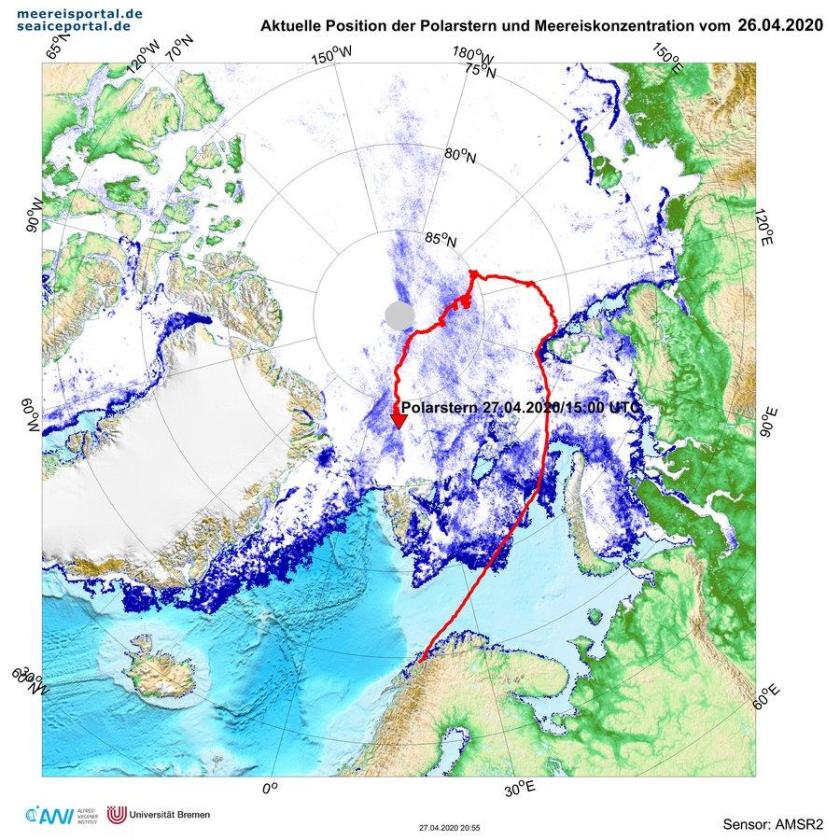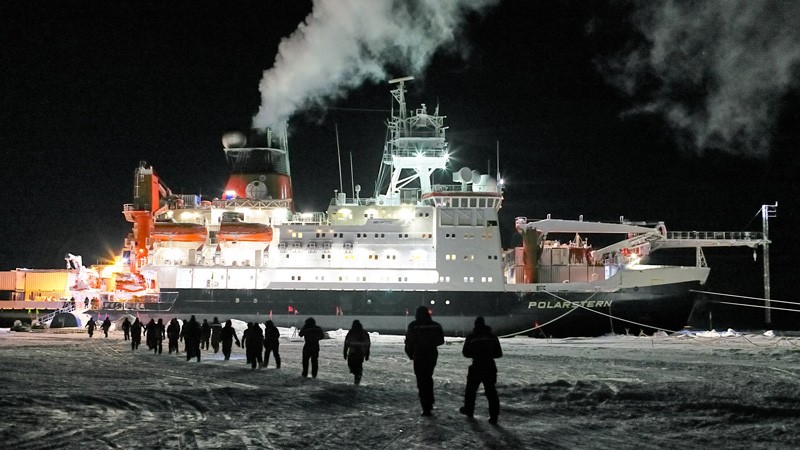The worldwide coronavirus lockdown has meant that the MOSAiC research project, which deliberately froze the icebreaker Polarstern into the Arctic Sea ice last fall, will miss taking scientific measurements during several critical weeks of the melt season (one of the main reasons for the project).

According to a report in the High North News(28 April 2020), at 27 April the Polarsternwas between Svalbard and the North Pole (map above). In mid-May, the ship will break out of the ice and proceed south to waters off Svalbard (expected to take about a week) to meet up with two German icebreakers for a high-seas exchange of crew and restock provisions, the only option available after the coronovirus lockdown in Svalbard meant the original plans had to be scuttled. And while waiting for the upcoming research upheaval and breaking free of the ice, the crew of the Polarstern recently reported a visit from a polar bear wandering the ice hunting for seals.

From a report in NATURE (24 April 2020, see image above),”Coronavirus shutdown forces research ship to break out of Arctic ice” (my bold):
When scientists were planning MOSAiC — an epic research expedition that would remain trapped in Arctic sea ice for one year — they considered the North Pole’s hazards. They worried about hypothermia, isolation, crushing ice and polar bears. They had dozens of contingency plans. But no one anticipated a pandemic.…
“The idea of leaving the camp and floe was certainly not something we would have considered in the original rotation plan,” Fong says. “But given what we’re encountering now, I think it’s an important compromise that recognizes that the human dimension to the work we do is very, very important.”
The pandemic also means coordinators are using meticulous precautions to ensure that no one carries the virus to the ship. The next rotation of scientists will arrive in Hamburg, Germany, on 1 May and go to Bremerhaven by private bus. There, they will be tested for the virus before going into individual quarantine. Assuming everyone is negative, they will undergo safety training in group isolation. After two weeks, they will travel to Svalbard on two German research vessels and board Polarstern before it returns to the research camp.
Although scientists plan to leave the research station mostly intact, certain measurements will have to stop. The remotely operated vehicle that dives into the ocean twice a week will be pulled out of the water. The tethered balloon that monitors the atmosphere will be packed away. And the scientists’ continuous collecting of ice and snow samples across the floe will stop.
“We’re going to do the best we can with these constraints,” says Matthew Shupe, an atmospheric and oceanic scientist at the University of Colorado Boulder and co-leader of MOSAiC. “But in the end, it’s a bummer.”
That is especially true, given that the gap will probably hit during a crucial time: when the ice begins to melt. Every spring, melting exposes dark ocean water, which absorbs more sunlight than does the ice. That warms the ocean further and spurs more melt in a vicious cycle that scientists are eager to study in detail.
It’s also when life in the Arctic flourishes. As sunlight penetrates farther into the ice and upper ocean, sea-ice algae and phytoplankton form massive blooms that provide meals for the rest of the Arctic food web. It has never been studied before in the central Arctic. Now scientists might miss it.
The High North News report says the Polarstern will likely reposition closer to the North Pole when it returns after resupply and staff exchange (my bold):
“While the first two crew exchanges at the end of 2019 and in late February happened as planned, an aerial transfer of staff and resupply out of Svalbard had to be canceled as Norwegian authorities have placed the archipelago on lockdown due to the pandemic.
In early April project leaders had considered chartering an icebreaker or moving a planned resupply mission of the icebreaker Odin from mid-June to mid-May. However, none of these options turned out to be feasible in light of the travel restrictions.
“The current situation also means [that] the international icebreakers that were originally meant to resupply the expedition are also prohibited from making any staff transfers,” explain officials from the Alfred-Wegener-Institute (AWI), the lead German government-funded research organization behind the expedition. “The massive restrictions on global travel hindered the third team exchange, which had been planned as an aerial transfer in early April, using the Spitsbergen archipelago as a base of operations.” …
Fortunately the drift corridor of the Polarstern has already taken the vessel in the direction of Svalbard and it is currently located between the North Pole and Fram Strait. “For the upcoming logistical operation, this position is advantageous. Some instruments on the MOSAiC ice floe will continue recording autonomously until Polarstern returns, while others will be dismantled,” explains the AWI.
The project leaders may also use the Polarstern’s departure from the ice as an opportunity to relocate the ice camp closer to the North Pole. This possibility has always been part of the planning scenarios in case the ship drifted faster than anticipated and will not have an impact on the scientific research being conducted. “If we drift too far south, we will set up the Ice Camp again farther north, and continue our observations in a region where the Central Arctic is still covered with ice in the summer.We’re thrilled with the tremendous amount of data we’ve been able to gather over the past seven months,” states expedition leader Prof Markus Rex from the AWI.
Other reports of the coronavirus-lockdown-disruption of this research project are foundhere, here and here.
On a lighter note, on 23 April 2020, while waiting to break out of the ice for the crew exchange mid-May, the Polarstern crew had a visit from a polar bear (below):

This past week [23 April 2020 according to one of the photos] we had the first polar bear sighting of leg 3. In the early morning hours, a curious male polar bear walked through the Central Observatory, checked out a few installations, played with a rubber fender, and continued on to about 800 meters from the ship. There it sat near a small crack in the ice for almost two hours, likely waiting for a seal to surface. It caused no damage and, given that no one was outside working at the time, led to very minor disruptions in our work. [my bold]

‘The polar bear viewed from the bridge of Polarstern. Here, it is standing behind Met City near a small lead, likely waiting for a seal. Photo by Steven Fons. ‘


